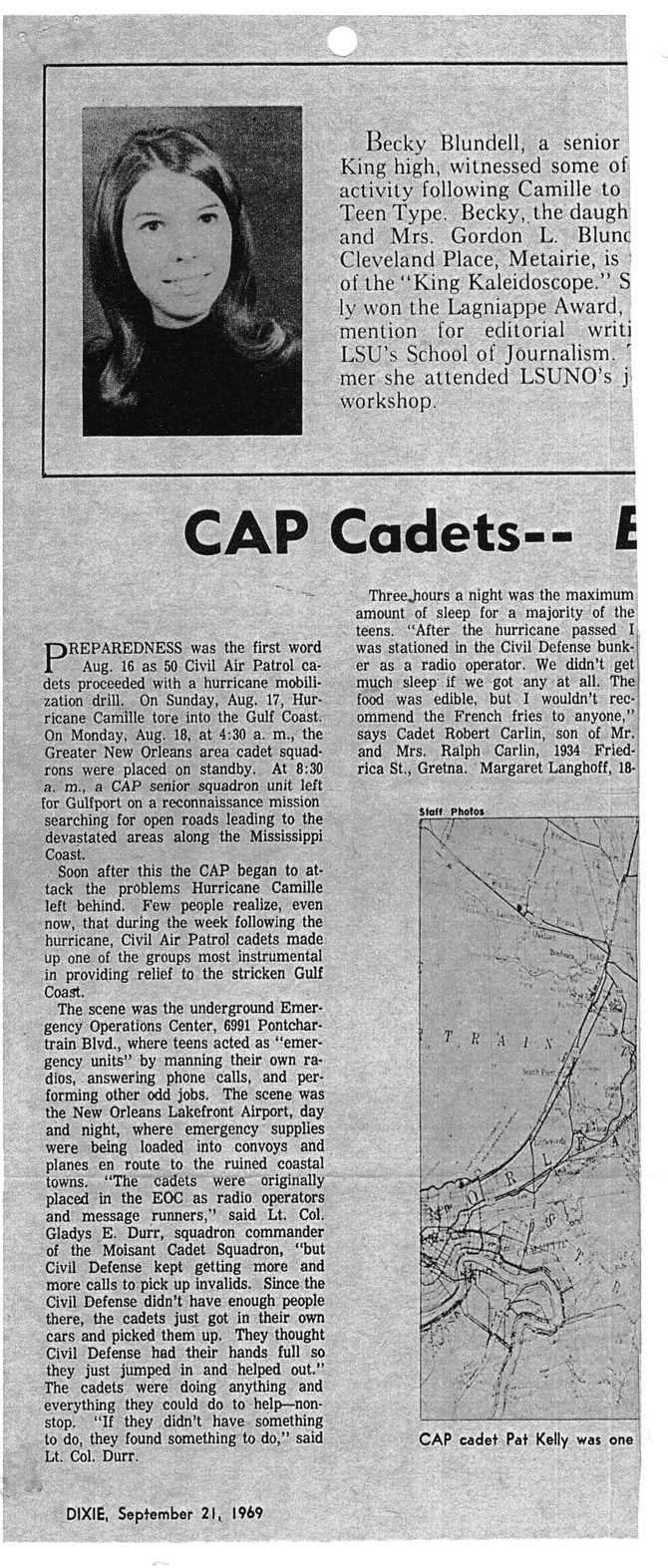This text was obtained via automated optical character recognition.
It has not been edited and may therefore contain several errors.
Becky Blundell, a senior King high, witnessed some of activity following Camille to Teen Type. Becky, the daugh and Mrs. Gordon L. Blunc Cleveland Place, Metairie, is of the “King Kaleidoscope.” S ly won the Lagniappe Award, mention for editorial writi LSU’s School of Journalism, mer she attended LSUNO’s j workshop. CAP Cadets-- I Preparedness was the first word Aug. 16 as 50 Civil Air Patrol cadets proceeded with a hurricane mobilization drill. On Sunday, Aug. 17, Hurricane Camille tore into the Gulf Coast. On Monday, Aug. 18, at 4:30 a. m., the Greater New Orleans area cadet squadrons were placed on standby. At 8:30 a. m., a CAP senior squadron unit left for Gulfport on a reconnaissance mission searching for open roads leading to the devastated areas along the Mississippi Coast. Soon after this the CAP began to attack the problems Hurricane Camille left behind. Few people realize, even now, that during the week following the hurricane, Civil Air Patrol cadets made up one of the groups most instrumental in providing relief to the stricken Gulf Coast. The scene was the underground Emergency Operations Center, 6991 Pontchar-train Blvd., where teens acted as “emergency units” by manning their own radios, answering phone calls, and performing other odd jobs. The scene was the New Orleans Lakefront Airport, day and night, where emergency supplies were being loaded into convoys and planes en route to the ruined coastal towns. “The cadets were originally placed in the EOC as radio operators and message runners,” said Lt. Col. Gladys E. Durr, squadron commander of the Moisant Cadet Squadron, “but Civil Defense kept getting more and more calls to pick up invalids. Since the Civil Defense didn’t have enough people there, the cadets just got in their own cars and picked them up. They thought Civil Defense had their hands full so they just jumped in and helped out.” The cadets were doing anything and everything they could do to help—nonstop. “If they didn’t have something to do, they found something to do,” said Lt. Col. Durr. Threejiours a night was the maximum amount of sleep for a majority of the teens. “After the hurricane passed I, was stationed in the Civil Defense bunk-! er as a radio operator. We didn't get: much sleep if we got any at all. The,1 food was edible, but I wouldn’t rec-i ommend the French fries to anyone,” says Cadet Robert Carlin, son of Mr. and Mrs. Ralph Carlin, 1934 Fried-rica St., Gretna. Margaret Langhoff, 18- Staff Photos DIXIE, September 21, 1969

Hurricane Camille Camille-Aftermath-Media (105)